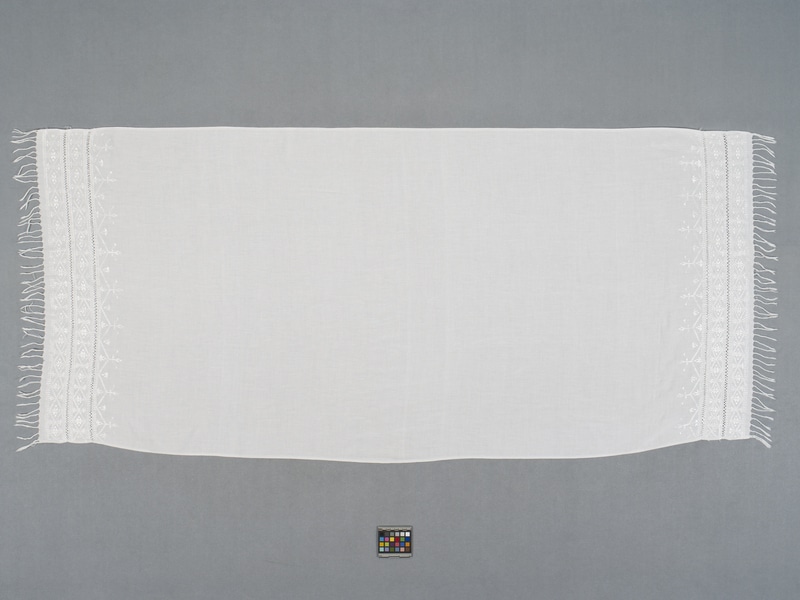Shawl Item Number: 2878/15 from the MOA: University of British Columbia

Description
White, rectangular shawl with a embroidery and fringe at each end, also in white thread. The design is broken up into three sections which are separated by a looser stitch. The first two sections have the same design of flowers and diamonds and the third design, that which is closest to the centre of the shawl, is flowers and triangles. Worn with 2878/14.
History Of Use
Traditionally, Chitrali women wear these cotton shawls or chador with topi hats (see 2878/14), the ends of the shawl crossed in front under the chin and tossed loosely back over the shoulders. However, rather than wearing a shawl in this open style, the more traditional way of wearing them (especially among Chitrali aristocracy) is as follows: the woman places the topi hat on top of her head (almost straight up from the forehead) and then winds a long scarf (usually white and fine cotton or silk) around and around the base of the topi like a turban, allowing the embroidered upper edge and top of the hat to show. One end of the scarf is covered up under layers of the wound cloth and the loose end goes under the chin and tucks up into the 'turban' on the opposite side at the ear. If their father-in-law, other older male relatives or strangers appear in the household compound, then custom requires that the woman pulls up the shawl from under her chin to cover the lower half of her face.
Like the Kalash'a, Chitralis (Khos) believe that baring the top of one's head displeases god and may even bring spirit possession by evil forces upon oneself. Therefore all traditional Chitrali (Kho) women and men are obliged to wear some sort of headgear. These shawls or chodors are worn with embroidered hats (topi) that are stitched by Chitrali (Kho) women at home. Chitrali (Kho) women mark strict "purdah" (seclusion), a custom that may have ben adopted over time from the neighboring Pathans groups, where female seclusion is central to Pathan family pride and honour.
Item History
- Made in Chitral, Northwest Frontier, Pakistan
- Owned by Tamarin Productions Inc. before May 4, 2011
- Received from Tamarin Productions Inc. (Seller) and Ruth Read Bequest (Funding source) on May 4, 2011
What
- Name
- Shawl
- Identification Number
- 2878/15
- Type of Item
- shawl
- Material
- cotton fibre
- Overall
- height 82.0 cm, width 178.0 cm
Who
- Culture
- Chitrali
- Previous Owner
- Tamarin Productions Inc.
- Received from
- Tamarin Productions Inc. (Seller) and Ruth Read Bequest (Funding source)
Where
- Holding Institution
- MOA: University of British Columbia
- Made in
- Chitral, Northwest Frontier, Pakistan
When
- Ownership Date
- before May 4, 2011
- Acquisition Date
- on May 4, 2011
Other
- Item Classes
- textiles
- Condition
- excellent
- Accession Number
- 2878/0015